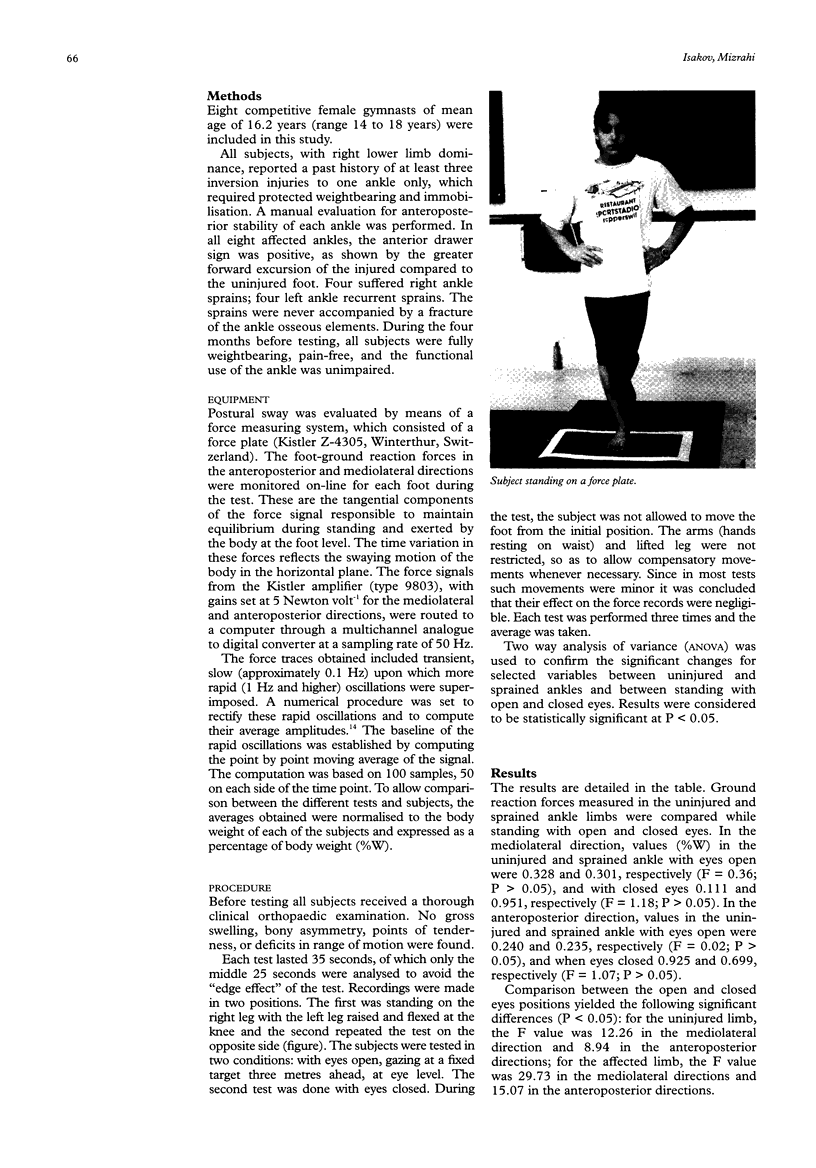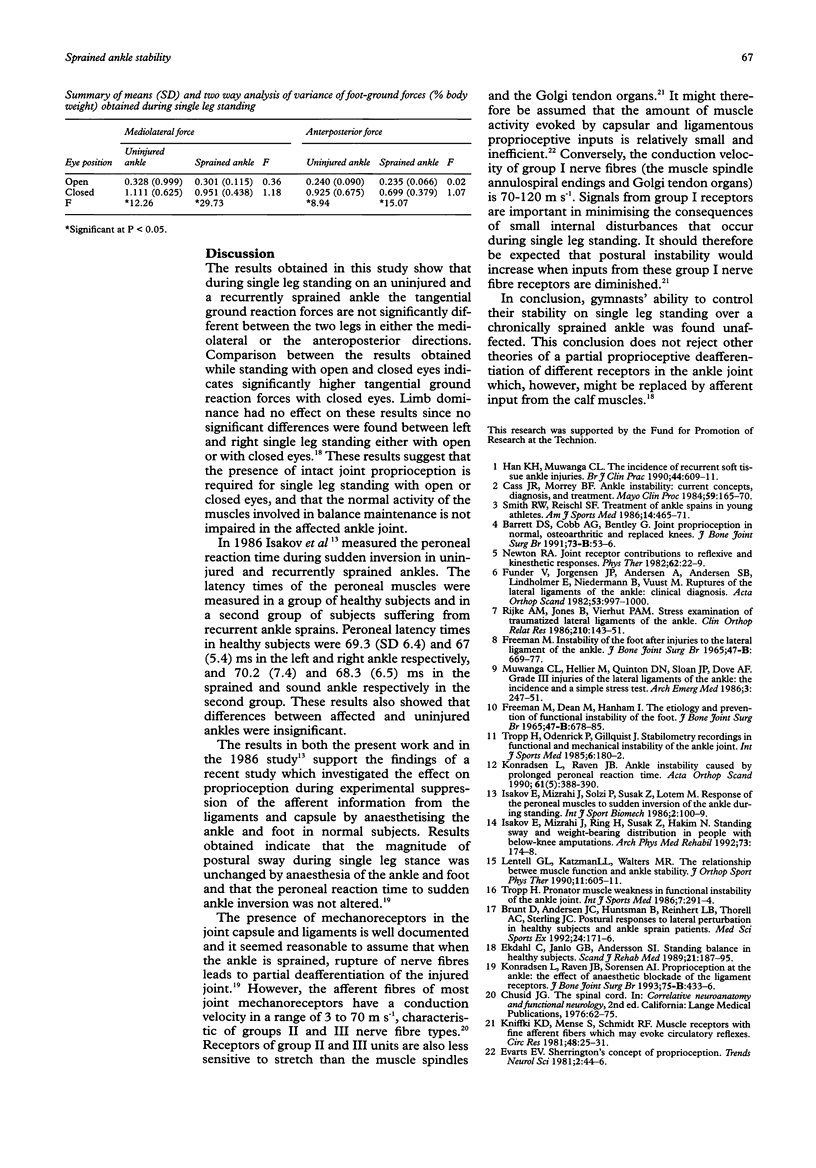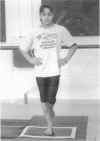Abstract
OBJECTIVE: To evaluate uninjured and recurrent sprained ankles during single leg standing, both with and without visual input, and the contribution of related proprioceptive feedback in this event. METHODS: A force measuring system was used for monitoring reaction forces in the anteroposterior and mediolateral directions during single leg standing. Differences between selected variables obtained in the uninjured and sprained ankles were analysed using two way analysis of variance. RESULTS: Foot-ground reaction forces in both anteroposterior and mediolateral directions were the same in normal and sprained ankles of each subject while standing with either open or closed eyes. However, standing with closed eyes, irrespective of the ankle status, always produced significantly higher reaction forces than those obtained with open eyes (P < 0.05). CONCLUSIONS: The amount of postural sway during single leg standing is similar in the chronically sprained and the uninjured ankle joint.
Full text
PDF


Images in this article
Selected References
These references are in PubMed. This may not be the complete list of references from this article.
- Barrett D. S., Cobb A. G., Bentley G. Joint proprioception in normal, osteoarthritic and replaced knees. J Bone Joint Surg Br. 1991 Jan;73(1):53–56. doi: 10.1302/0301-620X.73B1.1991775. [DOI] [PubMed] [Google Scholar]
- Brunt D., Andersen J. C., Huntsman B., Reinhert L. B., Thorell A. C., Sterling J. C. Postural responses to lateral perturbation in healthy subjects and ankle sprain patients. Med Sci Sports Exerc. 1992 Feb;24(2):171–176. [PubMed] [Google Scholar]
- Cass J. R., Morrey B. F. Ankle instability: current concepts, diagnosis, and treatment. Mayo Clin Proc. 1984 Mar;59(3):165–170. doi: 10.1016/s0025-6196(12)60769-1. [DOI] [PubMed] [Google Scholar]
- Ekdahl C., Jarnlo G. B., Andersson S. I. Standing balance in healthy subjects. Evaluation of a quantitative test battery on a force platform. Scand J Rehabil Med. 1989;21(4):187–195. [PubMed] [Google Scholar]
- Freeman M. A., Dean M. R., Hanham I. W. The etiology and prevention of functional instability of the foot. J Bone Joint Surg Br. 1965 Nov;47(4):678–685. [PubMed] [Google Scholar]
- Freeman M. A. Instability of the foot after injuries to the lateral ligament of the ankle. J Bone Joint Surg Br. 1965 Nov;47(4):669–677. [PubMed] [Google Scholar]
- Funder V., Jørgensen J. P., Andersen A., Andersen S. B., Lindholmer E., Niedermann B., Vuust M. Ruptures of the lateral ligaments of the ankle. Clinical diagnosis. Acta Orthop Scand. 1982 Dec;53(6):997–1000. doi: 10.3109/17453678208992860. [DOI] [PubMed] [Google Scholar]
- Han K. H., Muwanga C. L. The incidence of recurrent soft tissue ankle injuries. Br J Clin Pract. 1990 Dec;44(12):609–611. [PubMed] [Google Scholar]
- Isakov E., Mizrahi J., Ring H., Susak Z., Hakim N. Standing sway and weight-bearing distribution in people with below-knee amputations. Arch Phys Med Rehabil. 1992 Feb;73(2):174–178. [PubMed] [Google Scholar]
- Konradsen L., Ravn J. B. Ankle instability caused by prolonged peroneal reaction time. Acta Orthop Scand. 1990 Oct;61(5):388–390. doi: 10.3109/17453679008993546. [DOI] [PubMed] [Google Scholar]
- Konradsen L., Ravn J. B., Sørensen A. I. Proprioception at the ankle: the effect of anaesthetic blockade of ligament receptors. J Bone Joint Surg Br. 1993 May;75(3):433–436. doi: 10.1302/0301-620X.75B3.8496215. [DOI] [PubMed] [Google Scholar]
- Murray P. A., Vatner S. F. Reduction of maximal coronary vasodilator capacity in conscious dogs with severe right ventricular hypertrophy. Circ Res. 1981 Jan;48(1):25–33. doi: 10.1161/01.res.48.1.25. [DOI] [PubMed] [Google Scholar]
- Muwanga C. L., Hellier M., Quinton D. N., Sloan J. P., Dove A. F. Grade III injuries of the lateral ligaments of the ankle: the incidence and a simple stress test. Arch Emerg Med. 1986 Dec;3(4):247–251. doi: 10.1136/emj.3.4.247. [DOI] [PMC free article] [PubMed] [Google Scholar]
- Newton R. A. Joint receptor contributions to reflexive and kinesthetic responses. Phys Ther. 1982 Jan;62(1):22–29. doi: 10.1093/ptj/62.1.22. [DOI] [PubMed] [Google Scholar]
- Rijke A. M., Jones B., Vierhout P. A. Stress examination of traumatized lateral ligaments of the ankle. Clin Orthop Relat Res. 1986 Sep;(210):143–151. [PubMed] [Google Scholar]
- Smith R. W., Reischl S. F. Treatment of ankle sprains in young athletes. Am J Sports Med. 1986 Nov-Dec;14(6):465–471. doi: 10.1177/036354658601400606. [DOI] [PubMed] [Google Scholar]
- Tropp H., Odenrick P., Gillquist J. Stabilometry recordings in functional and mechanical instability of the ankle joint. Int J Sports Med. 1985 Jun;6(3):180–182. doi: 10.1055/s-2008-1025836. [DOI] [PubMed] [Google Scholar]
- Tropp H. Pronator muscle weakness in functional instability of the ankle joint. Int J Sports Med. 1986 Oct;7(5):291–294. doi: 10.1055/s-2008-1025777. [DOI] [PubMed] [Google Scholar]



